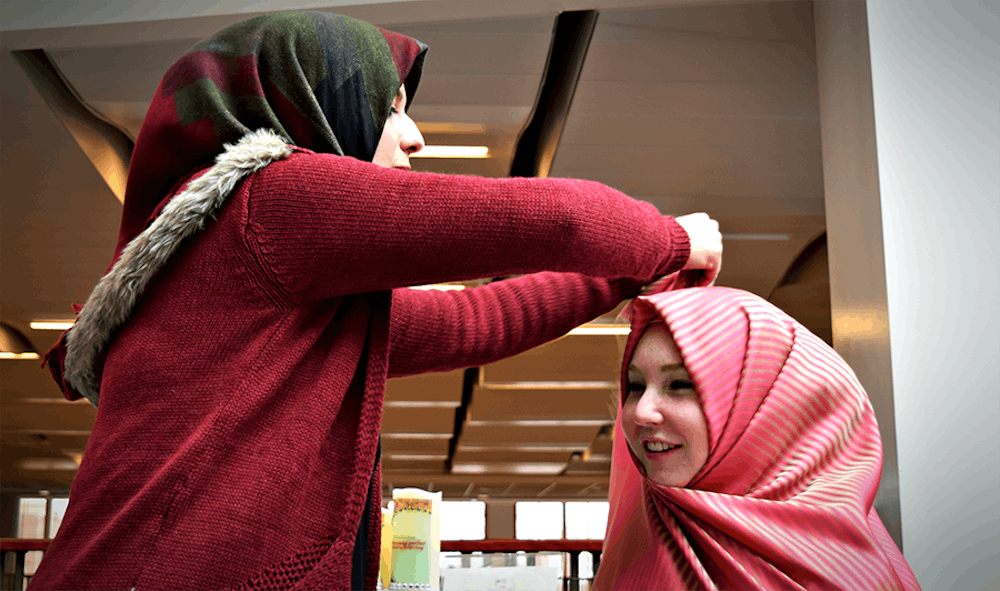A girl sat next to the brightly colored table, her hair being pinned up and covered with one of the cloths. The woman doing the styling twisted the fabric until it looked like the hijab on her own head.
First-year Nikki Sundrup stood up and let her friend take a picture of her in a bright pink hijab before posing for a photo with a sign that read, "I stand with her right to cover."
"I hate that so many people have so many misconceptions about the Muslim faith," Sundrup said. "The more I learn about the faith, the more I love it."
The Women's Center and Global Initiatives, with the help of Oxford community members, manned this table in Armstrong in observance of World Hijab Day on Feb. 1.
It was the first year of a planned annual event at Miami.
Rhonda Jackson, administrative assistant of the Women's Center, was one of the people manning the table and helping spread information about hijabs.
"It helps bridge some gaps and take away some unknowns, stereotypes and myths about practicing faith," Jackson said.
According to a press release for the event, New York resident Nazma Khan started this global event five years ago in order to raise awareness and end the stigma around hijabs and the abuse that women who wear them suffer regularly.
A hijab is a head covering that is a part of the Islamic faith. Women and men wear hijabs in order to show their devotion to their faith and to comply with the faith's teachings about modesty.
After the events of 9/11, the hijab became an even more obvious sign of the Islamic faith. It is often seen as a sinister symbol and has been banned in multiple countries including Germany, France and Turkey. Muslim women are often targeted and attacked for wearing hijabs.
Jackson is one of the founders of the international students group that aims to create a supportive environment for foreigners in the Oxford community.
Many of the members of this group are Muslim women.
A 2016 California State University, San Bernardino, study reported that in a survey of 20 states, attacks on Muslims increased by 79 percent in 2015.
World Hijab Day works to normalize hijabs and address the misconceptions about wearing them.
"It's no different than Christians wearing a cross, nuns wearing a habit or Jews wearing a yamaka," Jackson said. "It's just a show of someone's faith."
Those at the event stressed the fact that wearing a hijab is a choice. One of the issues that people have with the hijab is that they think it is a symbol of oppression and that women are forced to wear hijabs or other coverings.
"It is a choice," Jackson said, "Different sects within the faith approach things differently just like different sects within Christianity approach things differently. It's not about shame or anything like that. It's about a value."
By wearing a hijab for a few minutes and interacting with women who wear them everyday, Miami students became more exposed to this aspect of Muslim culture.
"I learned a lot of things," Sundrup said. "One was about how they're not forced to wear a hijab but that they have a lot of different reasons why they choose to wear them."
Students also had the opportunity to take a picture with signs declaring their support for Muslim women's right to wear hijabs.
Global Initiatives international student advisor, Sarah O'Connell, was one of the people taking the pictures.
O'Connell said that the pictures were tools for showing solidarity with the women around the world who were not allowed to practice their religion as they wished and were attacked for their beliefs.
In addition to the info table, the Women's Center and Global Initiatives also hosted a panel and TED talk to discuss the subject of hijabs.
"It's a lot about just learning and breaking down the barriers of being afraid to ask," Jackson said. "No matter how we identify with the color of our race or our culture, we have these common bonds. Even though we might practice our faith differently we have more things in common than not in common."

